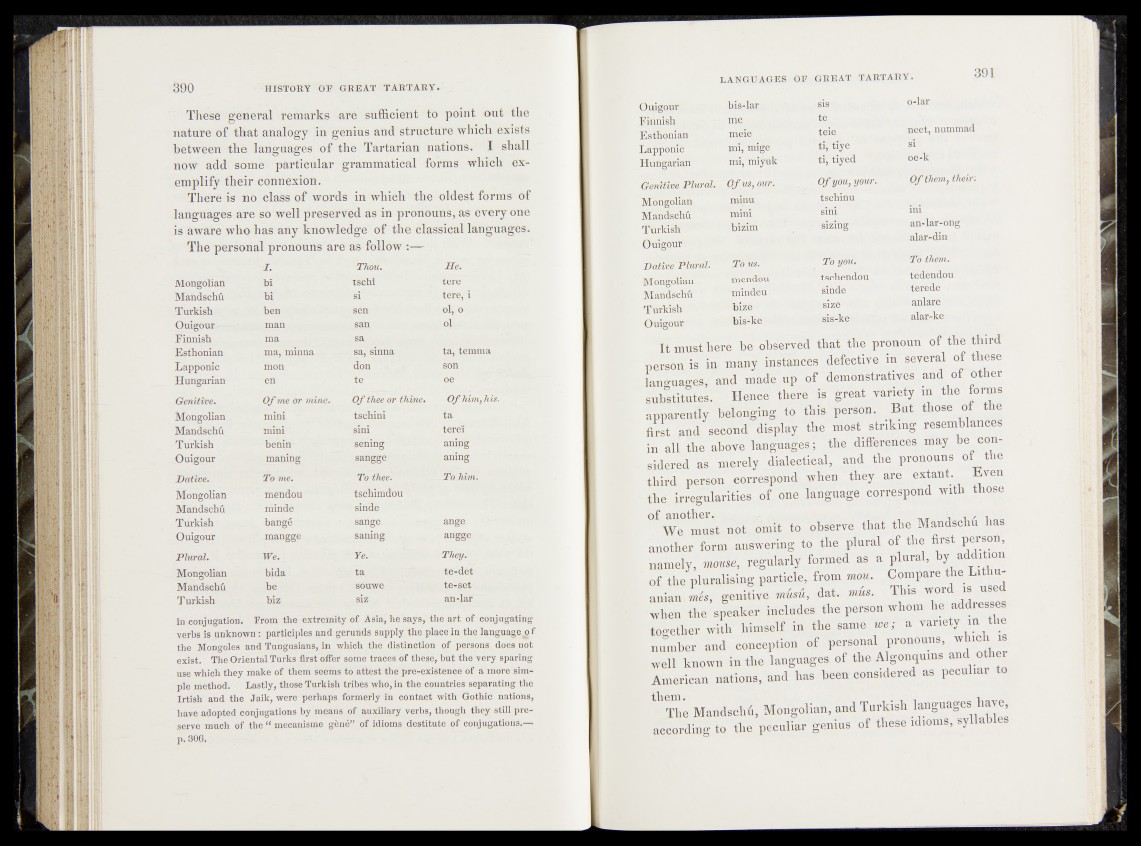
These general remarks are sufficient to point out the
nature of that analogy in genius and Structure which exists
between the languages of the Tartarian nations. I shall
now add some particular grammatical forms which exemplify
their connexion.
There is no class of words in which the oldest forms of
languages are so well preserved as in pronouns, as every one
is aware who has any knowledge of the classical languages.
The personal pronouns are as follow :— ,
-j.7; -Thou. He.
Mongoliair bi tschi tere
Mandschu bi ■ s i -'. \ ïeré, i
Turkish ben sen ol, o
Ouigour— % man san ■
Finnish ma sa
Esthonian ma, minna sa, sinna ta, temma;
Lapponic mon don son .
Hungarian en ‘'7'te o e '1
Genitive. O f me o r mine. O f thee o r thine. O f him, pis.
Mongolian mini tsebini '■-'jtót
Mandschu mini ’ sini tereï
Turkish beniir sening aning
Ouigour maning , sangge- anitig^
Dative. Tome. To thee. i.ToJiim.
Mongolian ‘ mehdou" tsclumdou
Mandschu minde sinde
Turkish bange sange '7
Otugour mangge saning angge |
Plural. We. Ye. They.
Mongolian bida - ta te-det
Mandschu be souwe te-set
Turkish biz siz . aü'laf
in conjugation. From the extremity of Asia, he says, the art of conjugating
verbs is unknown : participles and gerunds supply the place in the language^ f
the Mongoles and Tungusians, in which the distinction of persons does not
exist. The Oriental Turks first offer some traces of these, but the very sparing
use which they make of them seems to attest the pre-existence of a more simple
method. Lastly, those Turkish tribes who, in the countries separating the
Irtish and the Jaik, were perhaps formerly in contact with Gothic nations,
have adopted conjugations by means of auxiliary verbs, though they still preserve
much of the “ mecanisme g&ne” of idioms destitute of conjugations.—j
p. 306.
bis-l£y:rf<;
Finnish . me
tesffioniail - meie , '
Lapponic mi, triige'
Hungarian .^miymiyuk
Genitive Plural. . ( I f
Mongolian, “ .?
Mandscnff^ 75pm' ^
T'uriristi'" * biizim -3
’ Ouigour-
DativeP luraV ;r'T o us.
' Mongolian?’ uicndou
i .Mandschu ’ * i-,mindVii ’
Turkish
Ob$gdirEr t
.sis'
te
p-lar
neet, nummad
ff,'tiyê • si
t i|t iy ed
O f you, your. O f them, their:
^m r
an-lar-ong'
, alar-dim-.'
JTo'you. ^^Tomëm.
tscïïehdöu,u '
“size Ü^anlave' r
teisrkesr;.’ ^lar-ke
M W Observed that the $ro%in of the third
|H M H H in, many. H H B
langiSssk'and made up of deinbnstrati^.ahd.of other
!f t h s t i t u t j | Hence there , is great 1 the ®>™»
H H H belonging,40 ^ ^ B B"t - *^t>Se I he
first ■ ■ ■ ■ B I ^ ^ H B B i
in all the stove language!,; the B H | B mllJ B H B
sidered as m A diale A s ) ; a n d the pronouns of the
third person correspond when th < ^® g :rta n t. Even
fhe'irregularities of one wlth ,vf?,
°fWe must not_,ohi|f t o . ^ ^ f e , that tS^Mandsclfe has
another form ^Mwefing Jo, the fu ra l of the M B
namely, mouse,regularly fetinhd as a plural, by E M |
of the pluralising particle, from I Compare the Lithuanian.
m&, genitive m<u6, * * . H | This word is used
when the speaker includes the peteon whom he addresses
together with hims'eif in |^ ^ B I a B B I number and conception of f,phonal D^ouns, which is
well known in the languages of the Algouqums M M
American nations, and has heeii’ ® n s^ -e d as, peculiar to
H g Mandschti, Mongolian, ^ ^ B f f l B B H B B